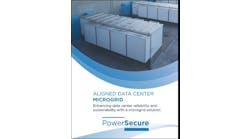Remote Australia Mining Town One Step Closer to New Energy Storage Center and Minigrid
Hydorstor, a global long duration energy storage developer and operator based in Canada, has signed a 65-year Crown Lands lease with the New South Wales (NSW), Australia, government, a significant milestone in the construction of the 1,600-MWh Silver City Energy Storage Center, which is slated to begin next year.
An advanced compressed air energy storage project, the Silver City Energy Storage Center will provide backup power and a minigrid system that will improve energy stability in Broken Hill, a remote outback mining community in the Far West region of New South Wales.
The energy storage center will be built near the Potosi mine, a Crown Lands site in the northeastern part of Broken Hill. Crown Lands include parks, reserves, assets, infrastructure, and lands that are managed by the NSW Department of Planning, Housing and Infrastructure on behalf of the public.
The Silver City Energy Storage Center is expected to generate 200 MW of power, which translates into eight hours of storage when discharged at full capacity, according to a statement from Hydrostor. If discharged at lower capacity, the storage time increases significantly.
The energy storage center will not only supply emissions-free power to the NSW grid, but it will also replace aging diesel fuel-powered turbines that currently provide backup power to Broken Hill’s nearly 18,000 residents.
“This is a major milestone in our journey toward realizing an extremely important project, not just for Broken Hill, but for Australia,” Martin Becker, vice president of origination and development for Hydrostor, said in a statement. “We look forward to delivering Silver City which is a critical missing piece in the state’s energy mix, and a much-needed solution for the region.”
Construction is expected to commence in 2025, pending development approval.
Avoiding future energy emergencies
Electric reliability has been an ongoing challenge in the Far West region of NSW. In October, the NSW government declared an energy emergency in that part of the state when a severe storm destroyed seven transmission towers and left communities, including Broken Hill, with significant power disruptions.
The energy emergency lasted until early November, when Transgrid, which operates and manages the NSW high voltage electricity transmission network, was able to complete repairs to its towers.
“Recent events in the Far West region of NSW have demonstrated the need for long duration storage to secure energy supply for Broken Hill and the Far West,” said Penny Sharpe, minister for climate change and energy. “This Silver City Energy Storage Facility is a solution that will make Broken Hill a renewable energy leader. The city will be generating, storing and distributing cleaner and more affordable energy to the Far West region and the rest of the state.”
Turn Buildings into Revenue Assets with Grid-Interactivity
New White Paper at Microgrid Knowledge
To help avoid future power intermittency challenges, and to protect Broken Hill’s residents from future outages, Hydrostor will also create a minigrid that will allow the storage center to leverage existing renewable energy infrastructure in the region. The minigrid will create a closed circuit that will fully power the town without the need to connect to Australia’s National Electric Market (NEM).
“We want to thank the NSW Government for recognizing the value of Silver City, long duration energy storage technology more broadly, and most importantly the potential for this project to protect the region’s energy through the establishment of a minigrid closed system in the event of outages. We are excited to deliver this project, which we are confident will benefit every member of the community,” Becker added.
The Silver City Energy Storage Project will serve NSW’s goal of increasing long-duration energy storage projects, improving the overall stability of the NEM. The project has received funding from the NSW Emerging Energy Opportunities Program and the Australian Renewable Energy Agency.








